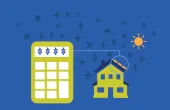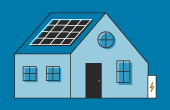The energy storage industry is always evolving, generating new and improved battery options for homeowners each day. For an example of this, look no further than Electriq Power – this California-based energy storage company just released a new product called the PowerPod 2 that comes with some impressive upgrades to their original PowerPod product, such as lithium-iron phosphate (LFP) chemistry and improved storage duration. We recently sat down with Electriq to learn more about their newest offering, and what’s coming up next:
Continue readingTips for talking solar this holiday season
It’s that time of year again when the sun starts to set earlier and earlier, especially here in Boston: already, it’s dark well before 5. But just because the number of daylight hours is dwindling towards its yearly nadir doesn’t mean it’s the wrong time to talk about solar.
Continue readingSGIP 2020 program updates: what you need to know
(Updated November 2020)
California’s Self Generation Incentive Program (SGIP) is one of the first incentives for battery energy storage in the country. The program has been very successful, helping California to lead the nation in residential energy storage deployment. Recently, the program has received additional funding, with a slightly revised charter for how to use those funds. Below, we detail the adjustments to SGIP and how it will impact individual, residential solar + storage shoppers in California.
Continue readingCommunity solar savings: why do seasons matter?
Community solar is one of the easiest ways to save on electricity bills. However, as you compare your options, you’ll notice that most community companies won’t provide an average monthly savings estimate, and there’s a very good reason for this – truthfully, your bills and savings can vary quite a bit from season to season. We’ll dive into why below.
Continue readingFloating solar: what you need to know
Not every roof is suitable for solar panels – factors such as shade, obstructions, age, and available space can have property owners looking for other locations for installation.
When it comes to large-scale solar projects, the most common alternatives to rooftop solar panel systems include ground mounts or solar canopies. Here’s a newer alternative that’s making quite the splash in the solar industry: floating solar.
Continue readingSolar news: November 13th, 2020
In this week’s Solar News Roundup, a Yale study on the support of transitioning to a clean economy, and Arizona’s new carbon-free generation requirement.
Continue readingHow to future proof your solar installation
People who invest in solar are inherently forward-looking: solar panels last for 25 years or more, producing clean energy for decades to come. For people who are considering a new solar–or solar plus storage–installation today, it’s worth thinking about more than just what solar panels to install on your property. There are a few specific ways that you can set up your solar panel system now so that it’s future-proofed for anything else you might want or purchase over the next three decades.
Continue readingBackup generators vs. energy storage: do the math
More and more homeowners are looking for ways to improve the resilience of their home’s electricity systems. Historically, many people who wanted backup power for their homes in the event of an emergency–think natural disasters and other outage events–looked to back up generators for that resilience. These days, however, homeowners are increasingly looking to energy storage systems, and solar plus storage systems in particular, for that peace of mind during outages.
Continue readingRoofing with solar panels: solar panel roof replacement logistics
A solar panel system will last you 30 to 35 years. In that time, your solar panels will generate plenty of savings on your electric bills.
Because solar panel systems have such a long life, many homeowners have questions about the impact this will have on their roof. How will the roof hold up over time? What if you have to remove and reinstall your solar panels for a roof replacement? Does your roof need to be prepped a certain way for solar panels to fit?
Continue readingWhich SDG&E rate schedule is best? Understanding peak hours
Are you a customer of San Diego Gas and Electric (SDG&E)? Whether you currently have solar panels on your roof, are considering solar, or don’t have any plans to generate your own electricity, SDG&E’s time-of-use (TOU) rates will have an impact on your monthly electricity costs. In the past, all SDG&E customers had the option of switching to TOU rates or remaining on their existing rate schedule. However, this began to change in early 2019 when SDG&E began the process of moving all residential customers (with a few exceptions) to a TOU plan. When it comes to choosing the right rate plan for your property, the best option for your home depends on your electricity use habits.
Continue reading




